Pals1 Study guides, Class notes & Summaries
Looking for the best study guides, study notes and summaries about Pals1? On this page you'll find 21 study documents about Pals1.
All 21 results
Sort by
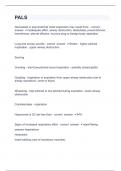
-
PALS1 Questions with complete solution
- Exam (elaborations) • 27 pages • 2024
-
Available in package deal
-
- $14.49
- + learn more
PALS1 Questions with complete solution PALS Decreased or asymmetrical chest expansion may result from: - correct answer inadequate effort, airway obstruction, atelectasis, pneumothorax, hemothorax, pleural effusion, mucous plug or foreign-body aspiration Lung and airway sounds - correct answer Stridor - higher pitched inspiration...upper airway obstruction Snoring Grunting - short,low-pitched sound expiration - partially closed glottis Gurgling - inspiration or expiration from...
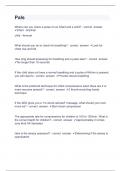
-
Pals1 Question and answers 100% correct
- Exam (elaborations) • 35 pages • 2024
-
Available in package deal
-
- $13.99
- + learn more
Pals1 Question and answers 100% correct Pals Where can you check a pulse on an infant and a child? - correct answer infant - brachial child - femoral What should you do to check for breathing? - correct answer Look for chest rise and fall. How long should assessing for breathing and a pulse take? - correct answer No longer than 10 seconds If the child does not have a normal breathing and a pulse of 64/min is present, you will need to - correct answer Provide rescue breathing...
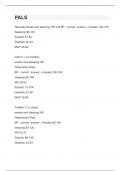
-
PALS1 Question and answers verified to pass
- Exam (elaborations) • 18 pages • 2024
-
Available in package deal
-
- $13.99
- + learn more
PALS1 Question and answers verified to pass PALS Neonate awake and sleeping HR and BP - correct answer Awake 100-125 Sleeping 90-160 Systolic 67-84 Diastolic 35-53 MAP 45-60 Infant (1-12 months) awake and sleeping HR Respiratory Rate BP - correct answer Awake 100-180 sleeping 90-160 RR 30-53 Systolic 72-104 Diastolic 37-56 MAP 50-62 Toddler (1-2 years) awake and sleeping HR Respiratory Rate BP - correct ans
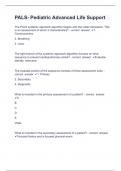
-
PALS1 Question and answers verified to pass
- Exam (elaborations) • 16 pages • 2024
-
Available in package deal
-
- $14.49
- + learn more
PALS1 Question and answers verified to pass PALS- Pediatric Advanced Life Support The PALS systemic approach algorithm begins with the initial impression. This is an assessment of which 3 characteristics? - correct answer 1. Consciousness 2. Breathing 3. Color The right branch of the systemic approach algorithm focuses on what sequence to prevent cardiopulmonary arrest? - correct answer Evaluate, Identify, Intervene The evaluate portion of the sequence consists of three assessmen...
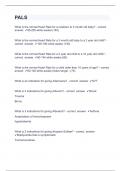
-
PALS1 Question and answers 100% correct
- Exam (elaborations) • 10 pages • 2024
-
Available in package deal
-
- $14.49
- + learn more
PALS1 Question and answers 100% correct PALS What is the normal Heart Rate for a newborn to 3 month old baby? - correct answer 85-205 while awake (140) What is the normal Heart Rate for a 3 month old baby to a 2 year old child? - correct answer 100-190 while awake (130) What is the normal Heart Rate for a 2 year old child to a 10 year old child? - correct answer 60-140 while awake (80) What is the normal Heart Rate for a child older than 10 years of age? - correct answer 60-...
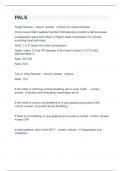
-
PALS1 Question and answer 100% correct
- Exam (elaborations) • 11 pages • 2024
-
Available in package deal
-
- $13.49
- + learn more
PALS1 Question and answer 100% correct PALS Single Rescuer - correct answer Check for responsiveness Check pulse Infant: palpate brachial Child:palpate a carotid or femoral pulse Compression placement Infant: 2 fingers chest compression or 2 thumb encircling hand technique. Child: 1 or 2 hands mid chest compression Depth: Infant: 1/3 the AP diameter of the infant's check (1 1/2") Child: approximately 2" Rate: 100-120 Ratio: 30:2 Two or more Rescuer - correct answer Same R...
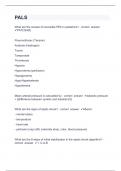
-
PALS1 Question and answers correctly solved
- Exam (elaborations) • 10 pages • 2024
-
Available in package deal
-
- $14.99
- + learn more
PALS1 Question and answers correctly solved PALS What are the causes of reversible PEA in pediatrics? - correct answer PAT(3)H(5) Pneumothorax (Tension) Acidosis (Hydrogen) Toxins Tamponade Thrombosis Hypoxia Hypovolemia (perfusion) Hypoglycemia Hypo/Hyperkalemia Hypothermia Mean arterial pressure is calculated by - correct answer diastolic pressure + [(difference between systolic and diastolic)/3] What are the signs of septic shock? - correct answer Altered - mental...
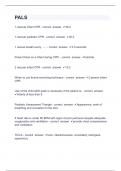
-
PALS1 Question and answers rated A+
- Exam (elaborations) • 9 pages • 2024
-
Available in package deal
-
- $14.49
- + learn more
PALS1 Question and answers rated A+ PALS 1-rescuer infant CPR - correct answer 30:2 1-rescuer pediatric CPR - correct answer 30:2 1 rescue breath every ...... - correct answer 3-5 seconds Pulse Check on a infant during CPR: - correct answer brachial 2 rescuer infant CPR - correct answer 15:2 When to use thumb encircling technique - correct answer 2-person infant CPR Use of the child AED pads is necessary if the patient is: - correct answer Infants of less than ...
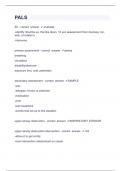
-
PALS1 Questions with complete solution
- Exam (elaborations) • 9 pages • 2024
-
Available in package deal
-
- $15.49
- + learn more
PALS1 Questions with complete solution PALS In children most cardiac arrest results from what - correct answer progressive respiratory failure, shock or both What three things are you looking at during the inital impression? - correct answer Consciousness, Breathing, Color Levels of consciousness - correct answer Unresponsive, irritable, alert What could a flushed appearance suggest> - correct answer fever or presence of toxin You come upon a
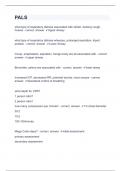
-
PALS1 Question and answers already passed
- Exam (elaborations) • 9 pages • 2024
-
Available in package deal
-
- $13.99
- + learn more
PALS1 Question and answers already passed PALS what type of respiratory distress associated with stridor, barking cough, hoarse - correct answer Upper Airway what type of respiratory distress wheezes, prolonged expiration, tripod position - correct answer Lower Airway Croup, anaphalaxis, aspiration, foreign body are all associated with - correct answer upper airway Bronchitis, ashma are associated with - correct answer lower aiway Increased ICP, decreased RR, potenital to...

How much did you already spend on Stuvia? Imagine there are plenty more of you out there paying for study notes, but this time YOU are the seller. Ka-ching! Discover all about earning on Stuvia


